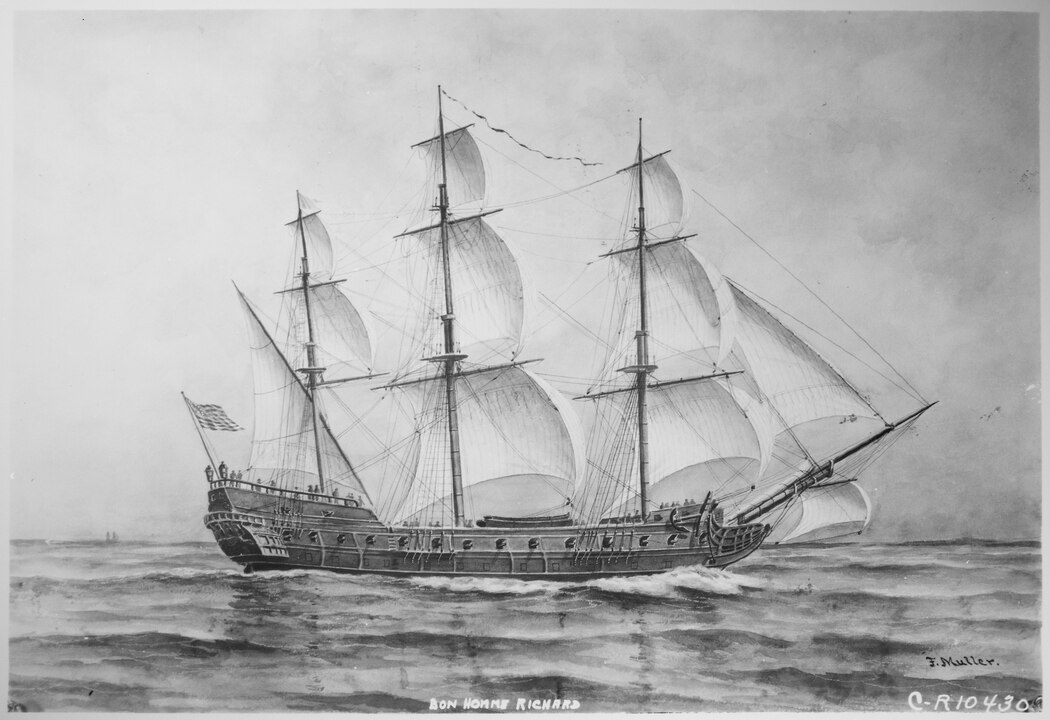
The Last Jedi is a (flawed) classic that completes the mythic cycle. Luke Skywalker is still a hero.
(CONTAINS SPOILERS)
Star Wars: The Last Jedi is Luke Skywalker’s final chapter in the mythic cycle that George Lucas began with the original 1977 Star Wars film, now called A New Hope. That’s why, despite the flaws in any Hollywood movie, The Last Jediwill become a classic.
As every Star Wars fan knows, Lucas based the character of Luke Skywalker on the monomythic hero in Joseph Campbell’s The Hero with a Thousand Faces (The Collected Works of Joseph Campbell)
What those Star Wars fans who now hate the new movie because of how Luke Skywalker is portrayed aren’t asking is (as Joseph Campbell did in his writing over the decades) “what happens to heroes when they grow older?”
That other question the angry fans fail to ask, is what happens when your past, your experiences, your actions and decisions, good or bad or grey begin to catch up with you?
The Last Jedi is only a movie, yes. But Star Wars is a cultural juggernaut that touches millions at their deepest levels — thanks to its universal mythic context.
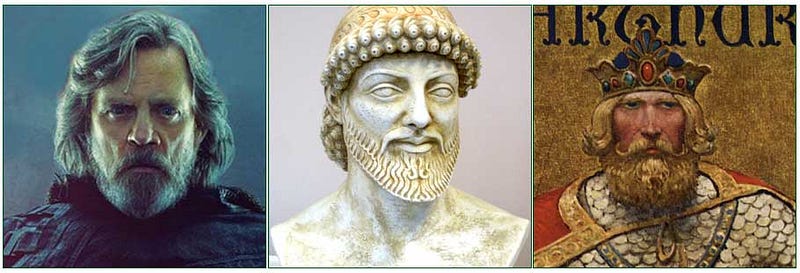
Luke Skywalker, Odysseus and King Arthur all faced challenges in their old age.
All those boys and young men who once imagined themselves as the heroic young warrior Luke Skywalker must now face the fact in The Last Jedi that one day they too will grow old. Avoiding the complete mythic cycle — refusing the mythic call — is the source of all their anger — Luke “in a nursing home” as one tweet put it or as another writer, Joseph Choi says “a terrified and cowardly old man committed to dying alone wallowing in regret.” Those fans have forgotten the role of the monomythic cycle is not just how the young hero comes through the road of trials but how to face your impending old age and death.
As the hero ages, he is in many cases no longer the warrior he was when he was young and thus is fated to follow ( or chooses) a new path.
It’s clear that many of the fans would prefer that Luke Skywalker become like the Samurai Zen sword master or even Gandalf the Grey/White. Characters like those do appear as mentors and threshold guardians in mythology. As Campbell pointed out, mythology challenges our deepest psych and that’s why the human mentor/threshold guardian (and sometimes even the gods themselves) are flawed.
At the same time all those fans that are raging over the aging Luke, no one (apart from some conservative commentators in the United States) is apparently angry over how following the same monomyth that the late Carrie Fisher changed over the decades from the feisty rebel princess to the wise woman General Leia Organa. The key is that although Luke and Leia are twins, their life paths have been very different.
Mythology around this world tells the stories of the hero after he or she complete the first cycle and returns. That subsequent life while often heroic it is not always on the light side and the story is often tragic.
What the world prefers is Achilles who has a choice of dying like a hero or returning home. Achilles chooses to die at Troy. As Achilles tells Odysseus in the Iliad.
“For my mother the goddess, silver-footed Thetis, tells me that twofold fates are bearing me toward the doom of death: if I abide here and play my part in the siege of Troy, then lost is my home-return, but my renown shall be imperishable; but if I return home to my dear native land, lost then is my glorious renown, yet shall my life long endure, neither shall the doom of death come soon upon me.”
As Joseph Campbell wrote in A Hero With a Thousand Faces back in 1948, “In the United States….the goal is not to grow old; but to remain young… worshipping at their boyhood shrines, becoming lawyers, merchants or masterminds, their parents wanted them to be…”
Achilles dies. His death is not exactly heroic, shot by an arrow in his one vulnerable spot, the back of his heel.
The Hollywood hero usually rides into the sunset or comes home and lives happily ever after. Whether or not director and writer Rian Johnson intended it in the script, he does create that last cycle of the monomyth. Unlike George Lucas in 1977 talking about Star Wars, there is no mention of the Campbell monomyth in the current round of interviews on The Last Jedi. But then the Force may have driven Johnson in a direction that he was unaware. Johnson as both writer and director developed the characters of Luke and Leila, at a time in where “life long endures and the doom of death comes late” (or in the case of Luke he uses the Force to transfer to a different plane).
Mark Hamill’s reservations about the role are well known, but despite telling Johnson the character is “not my Luke Skywalker” his brilliant performance captures, the flawed, vulnerable, hurt aging hero, scarred by life, the human hero the decades have made so different from the young farm boy that first met Obi-wan Kenobi.
Hamill also said in the interview. “Jedis don’t give up. I mean, even if he had a problem, he would maybe take a year to regroup.”
With that I am going to disagree. Jedis are just as human like the rest of us, we who can’t tap into the power of the Force. As both mythology and history shows, the original heroic journey often damages or maims, that is part of the price of being a mythic hero. It is true that Campbell doesn’t mention the maimed hero that much in The Hero with a Thousand Faces. The maimed, wounded hero is covered extensively in Campbell’s The Masks of God: Complete Four Volume Set
So like today’s human veterans, even for heroes recovery often takes years, if not decades. Jedis don’t give up but the final heroic journey is (to borrow a quote) a long and winding road that takes years. Just what was Obi-Wan Kenobi doing for the twenty years that old hermit lived out across the Dune Sea? Watching over Luke, yes, but also remember his anguished cry that he loved Anakin Skywalker as a brother. Just what was Yoda doing while he was hidden away in the shrouded in the mists of the swamp world Dagobah from Darth Vader and the Empire following the massacre of the Jedi, after everything he had worked for the past 800 year had collapsed?
As Joseph Campbell says in Myths to Live By
”no sooner have you learned your adult job and gained a place for yourself in society than you begin to feel the creak of old age….You now have a damaged psyche on your hands, your own…”
So for the aging male hero (we’ll talk about Leia and females later) there are number of destinies (sometimes choices but often the rule of the Fates). The hero can, as Campbell observes, turn to the dark side and become an emperor and tyrant. Or the hero embraces the light side to become a saint, a sage, a world redeemer. The third choice is to choose or be fated to embark on a final journey, what Campbell calls the departure of the hero. That journey is not always pleasant or successful, but that last journey to departure is the story of Luke Skywalker in The Last Jedi.
Odysseus in the ebbing time of a sleek old age
If you could be at Troy when Achilles spoke to Odysseus, you have to wonder what Odysseus would have thought had he known what would happen to him?
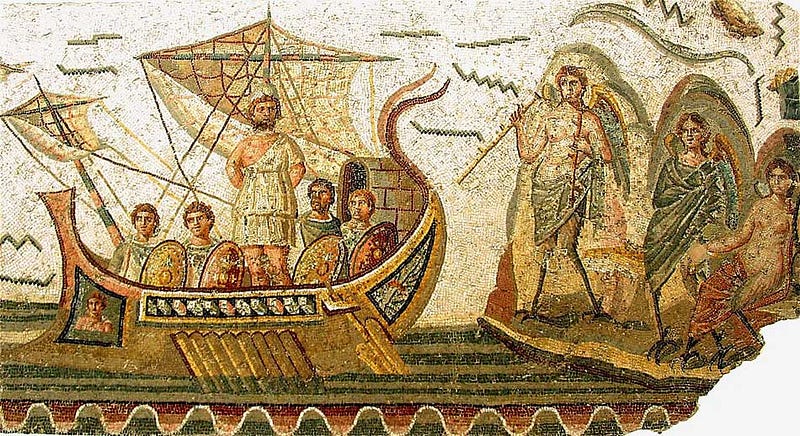
Odysseus and the Sirens Ulixes mosaic at the Bardo National Museum in Tunis, Tunisia, 2nd century AD Giorcesderivative work: Habib M’henni — Wikipedia, Public Domain, Link
Odysseus is the brilliant strategist, trickster, “sacker of cities,” who exposed the young Achilles when his mother disguised him as a girl and the warrior who came up with the idea of the Trojan horse. As Campbell says some “benign or malignant agent” causes Odysseus’ fleet of twelve ships to be blown off course by the winds. Then while trying to get home, Odysseus is cursed by Poseidon, god of the sea, in revenge after Odysseus kills his son, the cyclops Polyphemus. Odysseus encounters the witch goddess Circe who at first turns his men into pigs. Guided by the god Hermes, Odysseus resists her magic and they become lovers. Odysseus has seen friends and companions die in the ten year siege of Troy. He sees more death, as his crew foolishly opens the bag of winds given by Aeolus and in sight of their home on Ithaca are driven off course again, to cornered by giants on Sicily who sink the ships with rocks and then spear the men like fish. Odysseus’s lone ship survives but sometime later is wrecked in a storm sent by Zeus after his men devour cattle sacred to the sun god. Odysseus finally makes it home to Ithaca after ten years at Troy and ten years wandering the Mediterranean. He has to face the suitors who have been abusing his wife Penelope. The suitors are slain and the family of Odysseus, Penelope and their son Telemachus are reunited.
The family can’t live happily ever after and Odysseus knows it. Odysseus is still cursed by Poseidon.
During his voyages, Odysseus visited the underworld and there he was told by the ghost of the blind, hermaphrodite or transgender seer Tiresias
“You must take up your well-shaped oar and go on a journey until you come where there are men living who know nothing of the sea, and who eat food that is not mixed with salt, who never have known ships…, who never have known-well-shaped oars, which act for ships as wings do. And I will tell you a very clear proof, and you cannot miss it. When, as you walk, some other wayfarer happens to meet you, and says you carry a winnow-fan on your bright shoulder, then you must plant your well-shaped oar in the ground, and render ceremonious sacrifice to the lord Poseidon… and make your way home again and render holy hecatombs to the immortal gods who hold the wide heaven, all of them in order. Death will come to you from the sea, in some altogether unwarlike way, and it will end you in the ebbing time of a sleek old age. Your people about you will be prosperous. All this is true that I tell you.”
There were ancient versions of how Odysseus died, that have survived only in fragments. One of those fragments is called the Telegony and is believed to have been written by Eugammon of Cyrene. In that story, Circe gives birth to a son, who names him Telegonos which means “born far away”. Once Telegonos has grown to manhood on the island of Aeaea, Circe tells him that Odysseus is his father. Another story the Epitome of the Bibliotheke recounts that Circe gave Telegonos a supernatural spear tipped with the sting of a poisonous stingray.
Telegonos goes in search of his father. A storm forces his ship to Ithaca. Telegonos doesn’t know he is at Ithaca. So like his father the raider and “sacker of cities” and in the custom of the time, he lands and begins to steal cattle. Odysseus and his men arrive to defend the island. In the fight, Telegonos killed Odysseus with his unusual spear, thereby partially fulfilling Tiresias’ prophecy that death would come to “out of the sea” through the poison of the ray.
But the prophecy did say that Odysseus would die “in some altogether unwarlike way.” So did Eugammon or the author of the Epitome prefer a heroic ending for Odysseus to please the audience of the (pre-Twitter) ancient world and that the story of how Odysseus really died is lost?
Theseus goes over to the Dark Side.
Theseus is regarded as the cultural hero of Athens. He was the son of King Aegeus of Athens and the daughter of the king of Troezen, Aethra; conceived while Aegeus was drunk. Aethra goes to the seashore and pours a libation to Poseidon, creating both a human and a divine father for the baby growing in her womb. Aegeus, knowing she will have a son, hides his sandals and sword under a stone that only a hero can move.
Theseus as a young man does move the stone. Only then does Aethra reveal who is father is. Theseus travels to Athens, becoming more of a hero defeating bandits along the way. At Athens he is a guest at court but doesn’t reveal his identity. Aegeus’s wife Medea recognizes Theseus as Aegeus’s son and so to preserve the throne for her own children, tries to poison him. Aegeus recognizes the sandals and sword and knocks the poisoned cup from Theseus’s hands (“I am your father”).
In the most famous part of the legend, Theseus travels to Crete with six other young men and seven young women to be sacrificed to the half man half bull the Minotaur. Ariadne the daughter of the king of Crete falls in love with Theseus and on the advice of Daedalus provides him with the string that guides him into the Labyrinth. Theseus slays the Minotaur, uses the string to guide his way out and escapes. Then instructed by Athena, Theseus leaves Ariadne and her sister Phaedra on the beach and sets sail. Unfortunately, he forgets to change the sail of his ship from black to white — the signal of success — and his father watching for the ship’s return, jumps off a cliff in despair, believing his son is dead.
It is after his return that Theseus turns to the Dark Side. Theseus falls into bad company when he meets and becomes best friends with a younger, reckless, ambitious prince named Pirithous. They decide to kidnap the most beautiful women they can imagine. For Theseus it is Helen (later of Troy) even though she is under age. Theseus leaves Helen with his mother but she is rescued by Castor and Pollux.
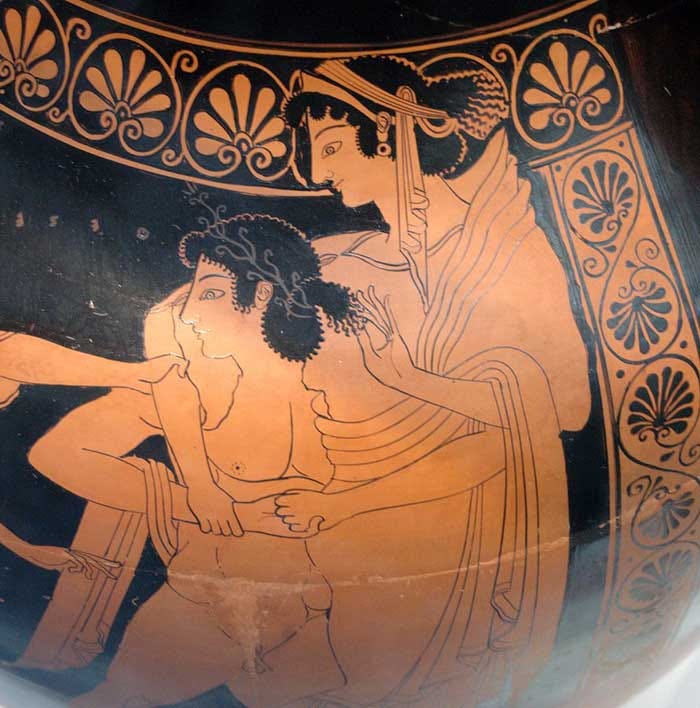
Theseus carries off the willing Helen, on an Attic red-figure amphora, c. 510 BC Wikipedia
Pirithous wants more than just a mortal woman; he wants Persephone, goddess of the underworld and consort of Hades. So the two go down to Hades. There are a couple of versions of what happens next, none them good for Theseus and Pirithous. In one Theseus sits down to rest on a rock at the gates of Tartarus. Theseus is turned stone, part of the rock, and cries out for help to Pirithous but it is too late. Pirithous too is imprisoned in stone. In another version, Hades knowing their plans invites both men to a feast and then as they sit down in chairs they are both turned to stone. Months, perhaps years go by both trapped in total darkness, before Hercules arrives to free Theseus. Pirithous is not as lucky, for his hubris in designing to abduct the wife of Hades, he remains in that stone chair tormented by the Furies for eternity.
The legends disagree on the timeline and stories of what happened to Theseus after his return from the underworld, but he does resume the throne of Athens. Theseus, having embraced what we would call the Dark Side becomes more and more tyrannical and is either overthrown or flees the city to exile on the island of Scyos. There the king of Scyos, probably fearing that Theseus will supplant him, throws Theseus off a cliff into the sea to his death. (Tyrants tossed over cliffs or down almost infinite chutes is a recurring Star Wars image)
Jason and the Argo
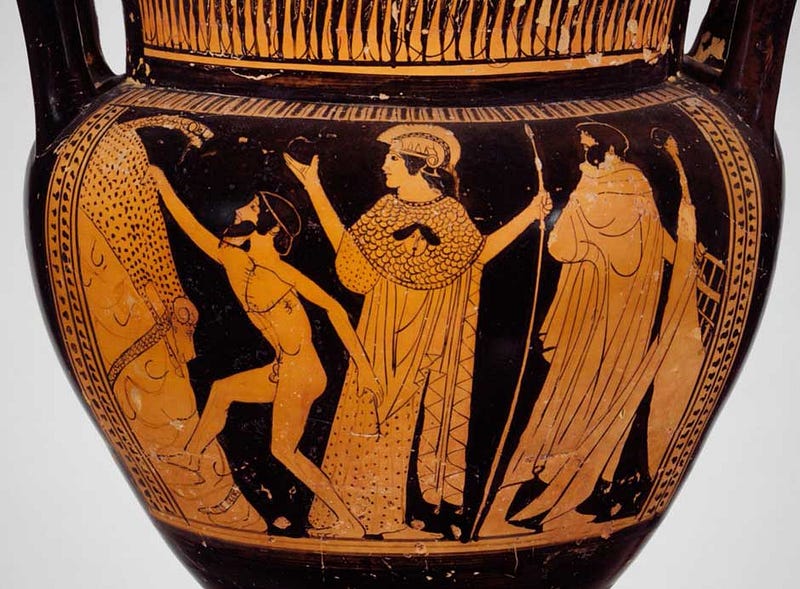
Jason steals the Golden Fleece.
Of all the heroes in the Western canon, Jason is perhaps the most unlucky and tragic. The story of Jason shows that Luke Skywalker is not following the path to become the pathetic old man that so many young would-be Jedi fear so much.
Jason is sent by his uncle, King Pelias (who fears Jason will take his throne) on the famous quest for the Golden Fleece. So he recruits a crew of the greatest Greek heroes of his time including Hercules, Castor and Pollux, the sons of Boreas — the north winds — and others. They sail from Greece in the Argo. Jason and the crew, the Argonauts, have many adventures on the way, including defeating the Harpies who are snatching food from Phineas each day and finding their way through the infamous clashing rocks until they arrive at Colchis, on the shores of what today is the Black Sea, the home of the famed Golden Fleece.
To retrieve the fleece Jason must perform three tasks. He his helped by the king’s daughter, Medea, who has the powers of a witch. She provides Jason with fire proof ointment so he can plow a field using fire-breathing oxen. Then he sows a field with dragon’s teeth which instantly appear as warriors. Medea tells Jason how to confuse the warriors by throwing a rock into their ranks, and they turn on each other. Finally, Medea gives Jason a potion so that the dragon guarding the fleece falls asleep.
Jason and Medea then flee with the Golden Fleece, pursued by her father the king, Aeetes. Medea kills her younger brother and cuts his body into pieces, flinging them into the sea. Aeetes stops to gather his son’s remains and thus the Argo escapes.
Jason’s life after the homecoming is never happy. He asks Medea to rejuvenate his own father. She does so by taking some of Aeson’s blood and adding herbs, then reinjects it. The daughters of King Pelias ask her to rejuvenate their father. She tells them to chop him into small pieces and boil the pieces in a cauldron. There are no magical herbs, Pelias is dead, his body mutilated. So Pelia’s son Acastus drives both Jason and Medea into exile.
They settle in Corinth where Jason dumps Medea to marry Creusa a daughter of Creon, the King of Corinth, Medea then exacts a terrible revenge; she gives Creusa a dress that clings to her body, burning it. Her father Creon also burns to death as he attempts to save her. Medea kills the two boys that Jason fathered and flees to Athens in chariot (some say drawn by dragons ).
Jason has lost his wife, his sons and the favour of the gods. For the rest of his life he is almost homeless, living in the hulk of the Argo, shunned, lonely and depressed. One night as he sleeps the rotting ship collapses around Jason, killing him.
King Arthur
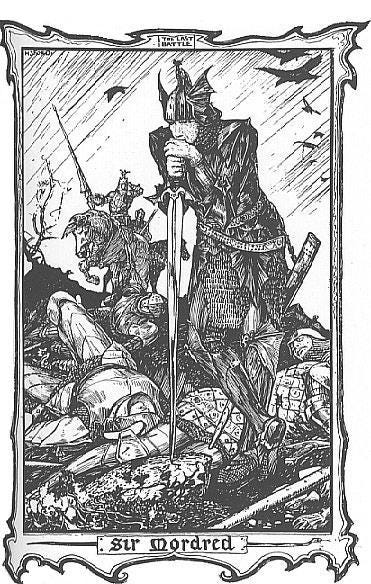
Sir Mordred (1902) by H. J. Ford Wikipedia
Readers, writers and Hollywood all love the story of the younger King Arthur, the boy, taught by Merlin, who is the only one who can pull the sword from the stone. There have been numerous movies how the warrior king Arthur defeats the Saxons and saves Briton, builds Camelot, creates the Round Table, sets out with his knights on the quest for the Holy Grail.
And then what? The years go on and Arthur becomes a middle aged, but still a vigorous king. However, he neglects his wife, Guinevere and she begins her affair with the handsome, younger Sir Lancelot. It is that adultery, in most of the Arthurian tales, the dooms the round table and Camelot.
As Arthur gets older, a young man appears at court. He is Mordred/Medraut. Mordred is Arthur’s son, conceived in incest, after Arthur was seduced by his sister, the witch woman, Margause/Morgan-Le-Fay.
While Arthur is away, Mordred, apparently with the cooperation of Guinevere, seizes the crown and leads a revolt against Arthur. The two forces meet in battle, father meets son in single combat. In many accounts Mordred is killed, in others he lives. Arthur is mortally wounded and taken to the isle of Avalon where he is said to sleep until he is needed once again by the British.
One account says that after the defeat of the Round Table by Mordred, Lancelot and eight of his kin (including other Knights of the Round Table) retreat to a hermitage to spend their lives in penance.
Merlin
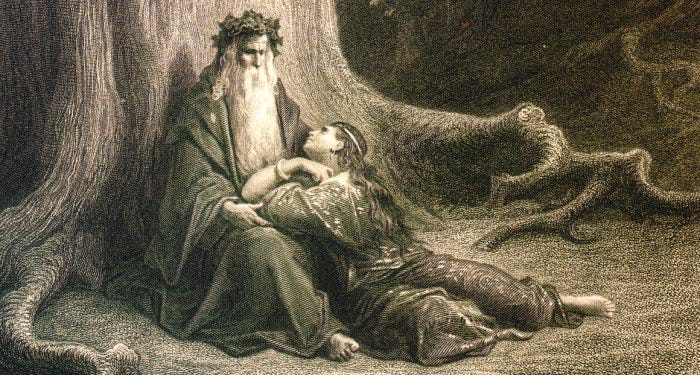
Vivien (or Niviane) and Merlin by the nineteenth-century French artist Gustave Dor
In his old age, the wise Merlin, the mentor and advisor to King Arthur, succumbs to a very human weakness. Depending on the account Merlin either is seduced by Niviane to become his student or lusts after her and he invites her to become his apprentice. In either case Niviane demands that Merlin teach him everything he knows. And that is his undoing; Niviane casts a spell on Merlin, imprisoning him forever in a tomb or cave.
As Palpatine/ Darth Sideus told Anakin Skywalker in The Revenge of the Sith, he persuaded his master, Darth Plagueis to teach him all he knows. Once he knows all, Palpatine/Sideus kills Plagueis in his sleep. (In Star Wars Legends, Palpatine also kills his own father)
So among the greatest characters in just the western mythic canon we see often the heroes don’t face well the fact the age and former deeds catch up to them. In two cases, the son kills his father, once deliberately once in a case of mistaken identity. A great knight retreats to become a hermit, a heroic sea voyager dies a homeless recluse. That’s just in the best known stories of the western classical canon, there are many more around the world, in all cultures. Of course, that fate is far from an upbeat Hollywood life story.
That means Luke’s retreat to the distant planet Ahch-To, site of an original Jedi Temple is perfectly in keeping with many of the heroes with a thousand faces.
And now to why Luke’s choice is heroic and why Mark Hamill’s performance is ground breaking that also captures the character perfectly.
Luke’s trauma
For the sake of argument, let’s imagine that if this year, Mark Hamill had reprised his role as Private Griff, the reluctant sniper in the Second World War movie, The Big Red One (1980) now as an older veteran, haunted in later life by memories of war there would be no doubt in anyone’s mind that Hamill would be on the short list for the Best Actor Oscar.
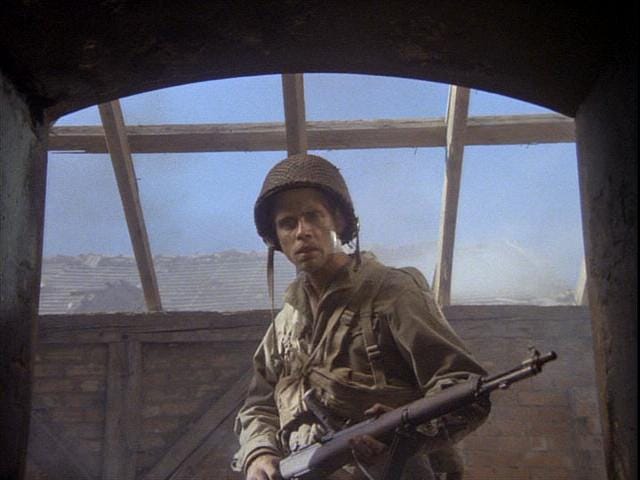
Mark Hamill as Pvt. Griff reacts at the horror of a concentration camp in the 1980 film The Big Red One (screengrab)
That sequel to The Big Red One would have to have been set in the mid-1980s, when the character of Griff, D-Day veteran from Omaha Beach, and liberator of a concentration camp, in his 60s, faces the memories that came from that war, demons that also challenge his family life.
Even if that Big Red One sequel was an independent movie (like the original), aimed at the art house circuit, it is unlikely that a film about a handsome young hero who becomes an angry old man, would get the financing it needed. Too much of a downer, the suits would say. On the other hand, Star Wars always makes a lot of money.
Let’s say that Big Red One sequel was produced. That means the audience going into the theatre would be aware that it is about a once young hero now facing late onset Post Traumatic Stress Disorder and accept that premise.
But we’re talking about Star Wars
As Mark Hamill said in his pre-release official interview with Starwars.com about the moment Obi-wan, played by Sir Alec Guinness, hands Luke the light sabre.
But it’s a pivotal scene when he gives me the lightsaber and says he wants me to do this, and I say, “No, I can’t, I’m going to get in trouble at home.” It’s relatable. Luke was nothing. He didn’t appear to be anything special. So for the audience to be able to see somebody like that, that they thought, “Well, you know, the space pirate is a little intimidating, and I don’t know how I would be around royalty, and the wizard is other-worldly.” Luke was like a guy you’d think, “Oh, I could hang out with him and be comfortable.” And what teenager can’t relate to, “Oh my god, I got to get home. I’m going to be in trouble for being late from my parents.” With all the fantasy going on, it was always rooted in things that the audience could relate to.
The source of the bewilderment and anger among the fans seems to be that when they go into the theatre they still want to hang out with Luke. That reaction reveals a larger problem in society, even after two decades of recent wars, that few people can relate to PTSD.
In reality, many of these aged heroes are worth hanging out with — but you have to get to know them, build trust, and that often takes a long time.
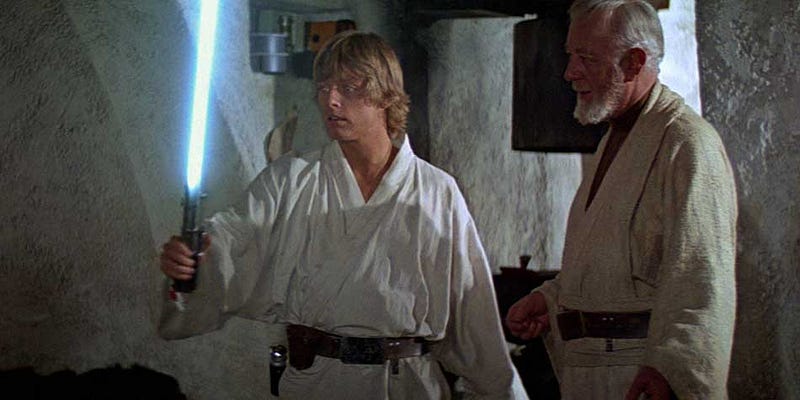
Obi-wan Kenobi (Alec Guiness) hands Luke Skywalker (Mark Hamill) his father’s light sabre in A New Hope (Stawars.com)
Hamill, despite his reluctance about Luke Skywalker in Rian Johnson’s script was able to create a superb character. Another reason that many fans hate the portrayal of Luke Skywalker, the exile, is that Johnson’s script doesn’t pay enough attention to how Luke came to be the hermit among the slate beehive huts on the Jedi Island on Ahch-To. We need to get to know the Luke in Ahch-To and that takes time. The script needs a lot more back story, the kind of back story that would be in that The Big Red One sequel.
But as can happen in movies and plays, the sum of the script, acting and direction can from time to time become better than the sum of those parts. That’s what happens in The Last Jedi despite the script limitations.

In just the first scene on the island I recognized in the character of the older Luke, people I’ve known all my life, the young heroes who spent their later lives with Post Traumatic Stress Disorder, including my own father. The others I met through my father, at veterans’ conferences and reunion and as scholar and journalist working on my master’s degree and writing my book A River Kwai Story The Sonkrai Tribunal.
Many of the men I’m talking about were prisoners and slave labourers on the infamous Burma Thailand Railway, the Railway of Death (And here there is another connection to Sir Alec Guinness in David Lean’s Bridge on the River Kwai). Others were combat veterans from the Second World War, Korea and Afghanistan.
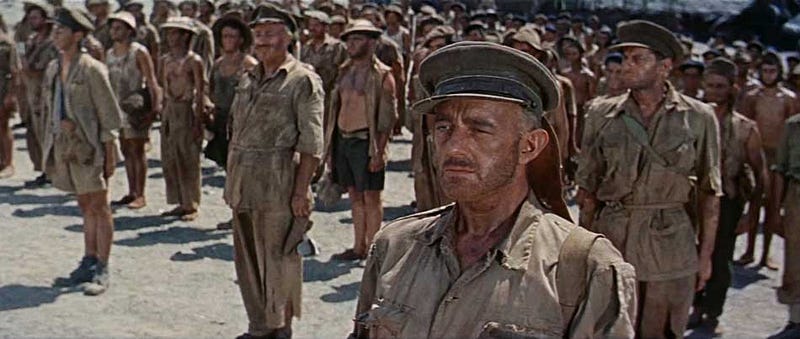
Alec Guinness in David Lean’s Bridge on the River Kwai
We think of those affected by PTSD as the young men who have returned from the war. But especially with the former Far East PoWs, it is now known there is a second dangerous time of life. It is after retirement, when there are no longer jobs to go to, when the children (if any) have left home, that often with no longer those preoccupations with the daily grind that memories and demons come back to haunt the veterans. Some deal with it successfully by publishing memoirs and going to speak in schools. Others, however, become uncertain and angry. Isolation, often chosen isolation if there is no one to talk to, can make it worse.
Mark Hamill has said in some interviews that as an actor’s choice he imagined he had a child killed in a light sabre accident. That certainly works in focusing and driving his performance.
Let’s consider for a moment the life and times of Luke Skywalker and why that light sabre incident (or something else if an official back story is created)might trigger his exile.
1. Luke has a hard life growing up on a Tattoine where his adopted parents Owen and Beru Lars are poor moisture farmers. Luke longs for a more adventurous life. He is told little about his dead father.
2. Owen and Beru Lars, the only parents he has ever known, and who clearly loved him, are brutally killed by Imperial Storm Troopers. The bodies are seen in the shot and would have been a traumatic experience for the young Luke.
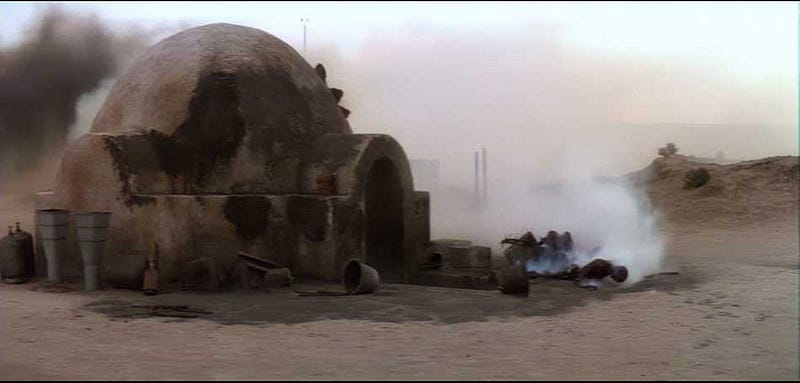
Luke’s aunt and uncle killed by Stormtroopers in A New Hope (Lucasfilm/Disney)
3. He finds a father figure and mentor in Obi-wan Kenobi. Obi-wan is starting to train Luke in the ways of the Force, but sacrifices himself in the light sabre duel with Darth Vader. That means as soon as Luke finds a father figure, he loses that father figure, seeing him killed. Another traumatic moment
4. Luke engages in combat, including the attack on the Death Star and the Battle of Hoth. That experience will add to what will happen in the future.
5. Luke finds a new mentor, threshold guide and father figure in Yoda, who fills the role of Obi-wan.
6. In attempting to rescue Han and Leia. Luke discovers that his father is not the hero of the Clone Wars but the evil Darth Vader who is attempting to turn Luke to the Dark Side. Two traumas, Obi-wan lied (understandably to spare Luke but always a revelation that hurts) and the fact that is father is the evil Force in the galaxy whom he has to fight.
7. In the fight with Darth Vader, Luke loses hand and part of his wrist, always a traumatic moment in anyone’s life.
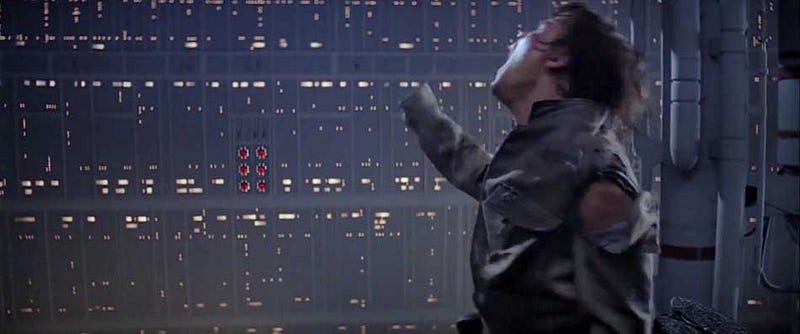
Luke loses his hand and wrist in the battle with Darth Vader (Lucasfilm/Disney)
8. Luke’s benign father figure Yoda, dies of old age, again leaving Luke without a living anchor.
9. Using the Force the spirit of Obi-wan tells Luke he must fight his father, Darth Vader. Trauma is adding up although Luke probably doesn’t realize it.
10. In the climactic scene of Return of the Jedi Luke attempts to bring Vader back to the light side but then realizes he has to protect his sister, Leia. He fights Vader, then is tortured by the Emperor Palpatine, only to be rescued by Vader. Father and son are reconciled, only have Luke watch his fourth father figure die. The Emperor’s torture sequence by itself would be enough to cause Post Traumatic Stress Disorder.
And the angry fans expect Luke Skywalker to be the same farm boy from Tattoine when he’s gone through all that?
Luke has gone through more than any of other Star Wars heroes. Leia had a comfortable upbringing on Aldaran and yes she saw her planet destroyed. Obi-wan was involved in battles and was betrayed by Anakin. None of those human heroes (I am omitting Yoda since little is known of his species’ psychology) suffer the up close and personal blows that Luke does.
Since Disney has assigned the post-Endor novel stories to the Legends category, we really don’t know that much about of what happens to Luke in the 40 odd years following the victory on Endor. We know that he founds a new Jedi academy, only to have it destroyed by Kylo Ren who then joins the First Order. Luke goes into exile on Ahch-To.
The Kylo-Ren incident is key
Luke Skywalker knows all too well that anger leads to the Dark Side. Anger is deeply embedded in the Skywalker genome as viewers have seen in the temptation and conversion of Anakin Skywalker into Darth Vader. The young Luke Skywalker spent a great deal of his energy working to control his anger so he would not turn to the Dark Side.
Anger, including bursts of rage, is a classic symptom of PTSD; I experienced those outbursts of rage as a kid. There are numerous accounts in the journalistic, legal and medical literature of episodes of rage and anger among veterans from every war suffering from PTSD.
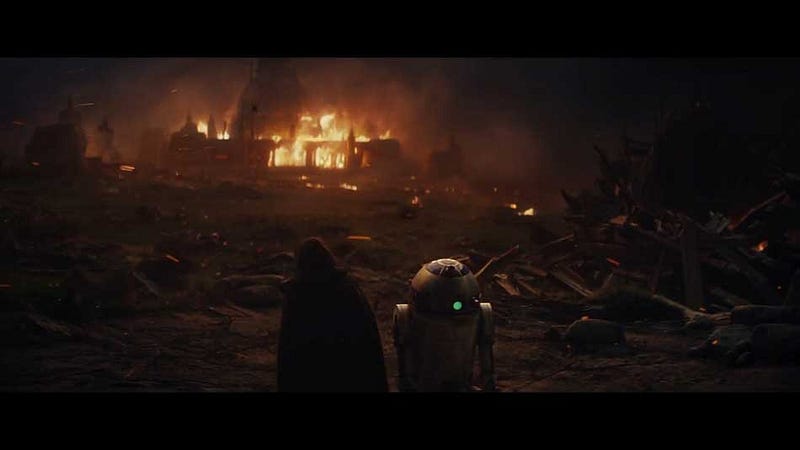
The destruction of the Jedi Academy (Lucasfilm/Disney)
That would mean as he grows older, Luke will be aware of the PTSD-related anger and rage building within him. It will take a lot of Luke’s energy to control and dampen that anger. Then when he finds that his prize pupil, his nephew, the son of his sister and his companion Han Solo, is turning to the dark side, for a moment — just a moment — that anger comes forth. While some fans hate that scene, Luke remains the hero he was as a young man, he blocks that anger at the last moment. He could have killed Kylo Ren and saved the galaxy from more misery but he doesn’t kill. For that Luke pays a heavy price, the destruction of his Jedi academy. So that is the time when it all overwhelms Luke and he retreats into the isolation of that Jedi island. That is until Rey shows up and there is a new call to adventure and the second turning of the monomythic cycle. At first Luke refuses the call, but his own conscience and a little prodding from the spirit of Yoda return him to the path.
As “the Last Jedi” Luke has no one to talk to
Among the veterans with PTSD I have known and interviewed, one thing is key. The ability to talk to someone who understands what they’ve been through. Often that meant gathering with other veterans to talk over experiences but not with family or friends. It is only recently that PTSD treatment includes psychological or psychiatric counselling. Even then the counselor must be a good listener.
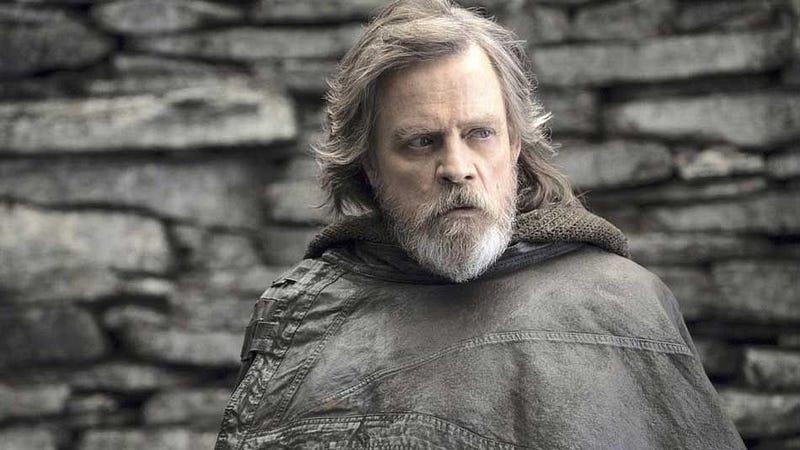
Isolation makes PTSD worse. What Luke Skywalker needed was another Jedi to talk to.(Lucasfilm/Disney)
As the presumably “Last Jedi” Luke has absolutely no one to talk to. His sister Leia is somewhere involved in politics and she did not experience everything that Luke experienced. His buddy Han wasn’t a Jedi and Han after splitting with Leia is crisscrossing the galaxy with Chewie.
Experience and research shows that if Luke actually did marry and have a wife and children, the last thing he would want to do is to talk to them about what he went through.
Luke would probably attend a reunion of the X-Wing Fighter Pilots Association and see how his old buddies are faring, But remember they are the fighter pilots, not Jedi, and so didn’t have the additional burden of being responsible for saving the galaxy.
He might talk to the spirits of Yoda or Obi-wan, but they are spirits, not living breath intelligent beings. It is likely Luke would have loved to have been able to hang out in a cantina with an old veteran Jedi he could talk to over some alcoholic beverage of choice on that planet. But there are no more Jedi.
So that means Luke is isolated even before he leaves for Ahch-To.
In his review in The Guardian, Peter Bradshaw gets it. He refers to Achilles with Luke “sulking in his tent.”
Whether or not Bradshaw knows the connection, with the sequelae (to use the medical term) from Vietnam, Iraq and Afghanistan, both scholars and medical professionals are taking a fresh look at our classical heritage. You’ll find it in Jonathan Shay’s book, Achilles in Vietnam: Combat Trauma and the Undoing of Character published back in 1995. Updated and fiercely debated in the 2014 collection of academic papers Combat Trauma and the Ancient Greeks (The New Antiquity)
The Theater of War: What Ancient Tragedies Can Teach Us Todaproject in the United States presents ancient Greek plays, many writen by classical authors who were veterans themselves to today`s veterans.
Those who come out of the PTSD closet today say the worst thing for them is the “suck it up” attitude from some of their comrades, some of their superior officers and often the ignorant public.
So saying “suck it up” to an older movie character so you can still have your childhood hero worship is not a good idea.
What I saw in the aging veterans I met and interviewed is that they don’t give up. But most of their energy is focused on fighting their demons. If we honour veterans with Post Traumatic Stress Disorder, then we can honour the saviour of the galaxy –even if it’s only a movie — as he too has to struggle with PTSD.
The rise of the Wise Women
Carrie Fisher as General Leia Organa and Laura Dern as Vice Admiral Amylin Holdos dominate The Last Jedi. Here we see the restoration of the wise woman from the mythological cycle to their proper role in the universe — as major characters, not briefly noted divine or enlightened horizon pointers along the way.
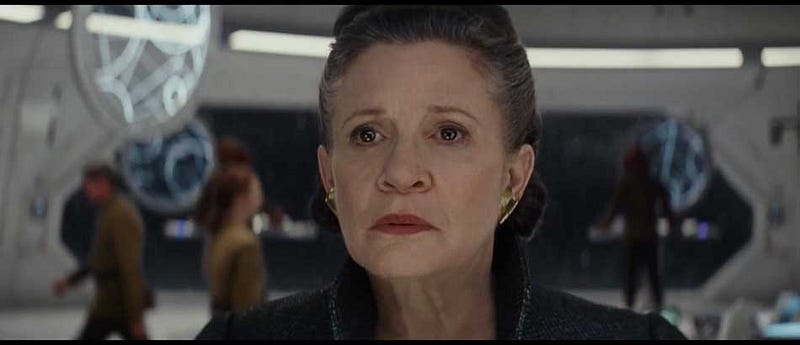
The late Carrie Fisher as General Leia Organa. now grown into a galactic wise woman and commander of rebel fores (Lucasfilm/Disney)
In Campbell’s monomythic cycle there is a major step not found in either the original Star Wars trilogy nor in the prequel — The Meeting With the Goddess — which can be a blessing or a curse, a help on the way or deadly dangerous. Why wasn’t there a wise woman in the original Star Wars series? Probably because she wouldn’t fit into George Lucas’s vision of replicating the old movie serials… so beloved by young boys.
The mythical woman can be Athena as Mentor teaching Telemachus, she can be Diana turning the unfortunate Acheron into a stag, she can be the famous Irish washer woman at the ford who foretells the death of heroes or she can be the woman, old or young, who tests a series of heroes until we discover the one is who the best and destined to be the greatest hero. Throughout The Hero With A Thousand Faces, Campbell notes the role of the wise woman as the one who calls the hero to adventure, as threshold guardian, as guide. He mentions an old woman in the Tanzanian legend of Kyazimba who helps him in his quest to know where the sun rises, the Spider Women tales from indigenous North America and the fairy godmother of European fairy tales.
As for Leia (and likely Vice Admiral Holdos) she goes through the three stages of the mythological female hero/goddess. First is the maid/virgin/warrior, second the matron/mother and finally the wise woman/crone/witch.
The mythological track is a lot more certain for females than it is for males, largely because, in general, those are the three stages of a woman’s life.
All three stages of the woman’s life can also be the temptress, like Medea, Niviane. The male may already be inclined to and on a path to the Dark Side and the temptress facilitates that move, as in the case of Lady MacBeth.
Leia is an adventure companion for the young Skywalker, not a goddess guide and certainly not a temptress.
So in the original series, Leia is the maiden warrior. We get just a glimpse of Leia as matron/mother in the passing mentions as the mother of Ben Solo in The Force Awakens. In The Last Jedi she is the wise woman who commands the rebel forces. And of course, the wise woman, who knows better and who is also acting as a threshold guide Leia, is perfectly right to chew out and demote the hotshot fly boy Poe Dameron, who although an experienced pilot and officer pushes the envelope too far. The audience will have to hope that in Episode IX Dameron, who is otherwise an attractive character, with hints of Han Solo, will learn from his mistakes. Leia the wise woman is an effective commander of the rebel forces and her decisions, help ensure the survival of the rebellion.
The Last Jedi has strong female protagonists, not only Leia and Holdos but Rey and Rose Tico.
Now that Carrie Fisher has passed on and Holdos died in combat, Episode IX will need a new wise woman to continue their work.
It’s too bad that I won’t be around thirty or forty years from now if this planet survives so Star Wars can continue and if Rey’s character grows and survives, so an audience can see Daisy Ridley play the Rey the Wise Woman.
What works and what doesn’t in The Last Jedi
To move from analysis to fandom.
Coming out of the theatre I was torn between giving The Last Jedi an A- or B+ but overall the film worked and worked well for me. Many of the sequence are flawed, but the whole package is greater than the sum of the parts.
The main flaw in The Last Jedi is that today’s motion picture aimed at a worldwide market emphasizes action and explosions over character development in the somewhat mistaken belief that’s what the international and non-English speaking market wants. That is why The Force Awakens and The Last Jedi are too uneven. Both the original trilogy and the prequel trilogy (with its flaws), produced before so much money was to be made in the international marketplace, found balance in the Force of script writing and direction between character and action.
The Last Jedi would have been a much better movie if there were a few less explosions and more time spent on developing Luke, Rey, Kylo Ren, Finn, Rose Tico and Poe Dameron.
Star Wars is popular enough to break that modern algorithmic timed beats mold and still make money for Disney/LucasFilm with future movies that do emphasize character over bang bang.
Ahch-To
The Ahch-To sequences work for me, because I can relate. If the scenes between Luke and Rey had more development, as Luke is conflicted between his need for isolation and healing and his calling to train Rey there would likely have been less negative audience reaction. There could be more to the reunion between Luke and R2-D2, after all “That little droid and I have been through a lot together.”
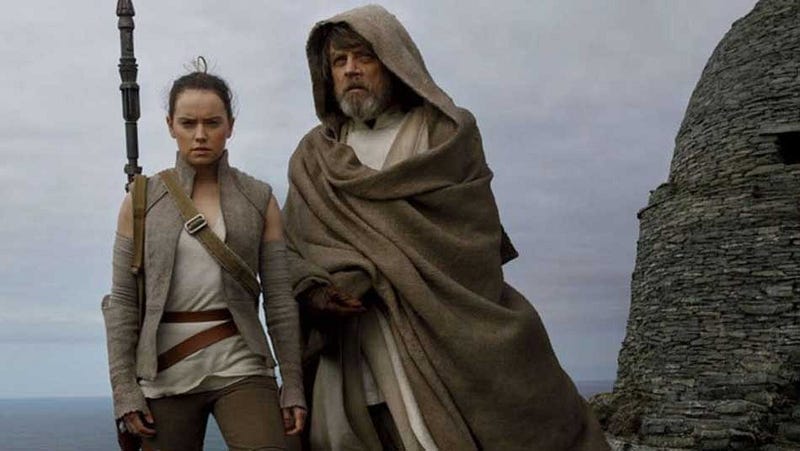
Rey (Daisy Ridley) and Luke (Mark Hamill) on the Jedi Island (Lucasfilm/Disney)
Those annoying Porgs were apparently inspired by the protected puffins that inhabit Skellig Michael but add very little to the story line (unlike the Ewoks in Return of the Jedi). As for the scene where the Porgs look at Chewbacca as he attempts to eat a bird of some kind, well what do you think the real monks who lived on the island in the Dark Ages lived on? Birds and fish. There is no indication in the film of a vegetable based diet, that could have been delivered to the island the caretakers. From the pre-publicity I had expected more. The Porgs could have been made a little more intelligent and perhaps could have had some more than a “background action” role. So it means the Porgs are little more than a money maker for toys. As for milking the sea cow that, like the caretakers, comes out of nowhere. That could have been developed more by cutting a couple of opening explosions.
The Dreadnaught Attack
The Dreadnaught battle is an exciting fast paced grab to get the audience into the movie but a bit too long. The overall Dreadnaught attack is plausible especially since it was likely based on the history of the 20th century where aircraft sank battleships and cruisers, not only at anchor at Pearl Harbor and the British attack on the Italian fleet in Taranto in 1940, but attacks on active warships, the Bismarck, the Prince of Wales and Repulse, the Yamato. There`s a lot of online controversy over the so-called “gravity bomb” attack on the Dreadnaught after Rose gets the bomb bay doors open. But there’s no indication that the bombs didn’t have some sort of guidance system that targeted the Dreadnaught.
Canto Bight
I really liked the Canto Bight casino sequence. Part of it is for personal reasons, but more than that as well, Arthur George who illustrated my 1988 short story “Wait Till Next Year” in Analog Science Fiction created an alien creature race. Different story, different creatures but a great idea (if I do say so myself).
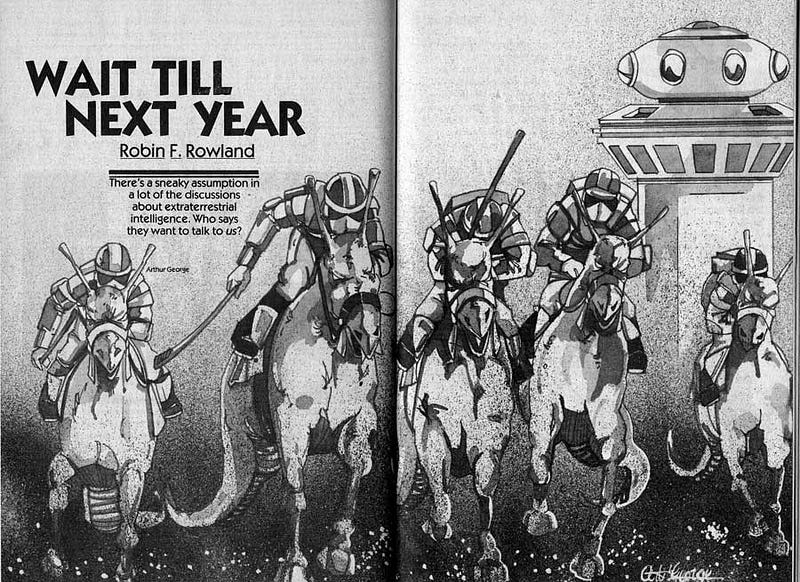
Wait Til Next Year Analog 1988
Again the Canto Bight sequence could have been developed a lot more. Perhaps it should actually have been the basis for a complete Star Wars film with Finn and Rose working to infiltrate the casino and find the code breaker, a sort of combination of the different versions of Casino Royale and all those Monte Carlo caper movies Hollywood has produced over the years. The sequence is beautifully shot, a perfect and delightful picture of the galactic one per cent celebrating in their decadence while the rest of the galaxy suffers from the war between the First Order and the Rebels. The freeing of the racing creatures and empowerment of the stable children are good foreshadowing of things to come. I have just one picky question. How did Finn and Rose, a couple of grubby space travelers get into the casino in the first place when every other character is dressed in designer originals? That’s why that sequence had to be developed.
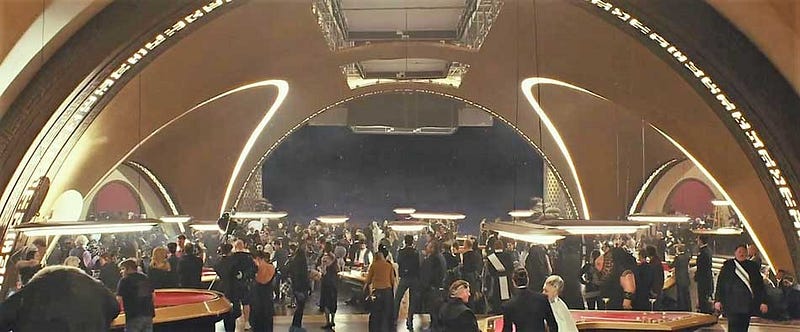
The glittering casino. (Lucasfilm/Disney)
The slow chase
The slow chase works, even when we’re talking about near light speed travel. Again it’s uncertain if Rian Johnson intended this, but that slow chase comes out of the age of fighting sail, when a chase depended on the winds and the sails and small, lighter ships could often outrun the ships of the line, right of C.S. Forester’s Hornblower series where the well trained Royal Navy crew can sometimes fire the guns and damage their quarry once they come in maximum range.
Kylo Ren and Rey
The relationship between the dark Kylo Ren and the still mysterious Rey is a high point of the movie. There some aspect of the Force linking the two. It’s also clear that Kylo Ren is a psychopath and that he is manipulating Rey. Are Rey’s parents really “nobodies” or is Kylo Ren lying to her? Why do so many people assume and become disappointed when they take Kylo Ren at his word (after all everyone believed in A New Hope that Luke’s father was a great Jedi warrior)
The final battle
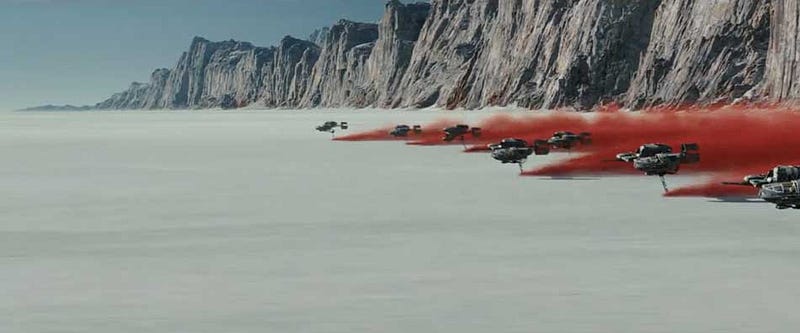
The final battle in The Last Jedi on the mineral world (Lucasfilm/Disney)
I have mixed feelings about the final battle on the salt planet Crail. There is a shot in the Last Jedi of Luke looking down at an X-wing fighter below the waves of the island. And that X-wing is never used, a direct violation of Chekhov’s’ Law “If in the first act you have hung a pistol on the wall, then in the following one it should be fired. Otherwise don’t put it there.”
So the battle scene is vintage Star Wars building from a fascinating alien world. When Luke appeared to fight Kylo Ren, I thought that somewhere there would be that X-wing. If an X-wing survived the swamp waters of Dagobah, it could also survive the salt water of Ahch-To. The spirit Yoda acts as a Campbell guide who awakes Luke and facilitates his return to the universe. So that creates the battle scene with Kylo Ren. Not entirely satisfying, If Kylo Ren is strong in the Force he should have known that Luke is a projection.
The climatic ending with the aged Luke willingly crossing over to the dimension of the spirit Force, as he looks at those amazing double sunset restores the mythic quality of Star Wars going back to A New Hope and that is how The Last Jedi finally becomes better than the sum of its flawed sequences.
Episode IX and the future of Star Wars.
I’ve spent a couple of days of the holiday on this.
Star Wars The Last Jedi is only a movie. But it’s more than a movie. George Lucas wanted to recreate the old movie serials of his youth. What he produced was a cultural icon.That’s why the fan reaction pro and con has been so fierce.
In his interview with Bill Moyers in The Power of Myth Joseph Campbell noted. “Fairy tales are for entertainment. You’ve got to distinguish between the myths that have to do with the serious matter of living life in terms of the order of society and of nature, and stories with some of those motifs that are told for entertainment.”
The dilemma for Star Wars is that it is both entertainment with millions of fans and more than entertainment because through the medium of the movie it often deals with the serious mythic matter of living, including Luke dealing with Post Traumatic Stress Disorder.
So here’s this fan’s expectations for Episode IX, the young Han Solo movie and the projected Rian Johnson trilogy.
I am willing to suspend disbelief but not all the laws of physics
I can forgive a snake with lots of teeth living in an asteroid, because the rest ofThe Empire Strikes Back was good.
There’s a rule taught by the old Masters of science fiction back in the Golden Age. If you’re going to break the laws of physics, break just one and obey the rest. That’s the problem with The Force Awakens and the Starkiller Base. That ability of the Starkiller Base to destroy a distant star system breaks multiple laws of physics. While a Death Star presumably has hyperdrive and thus move into close proximity of a system to destroy it, the Starkiller base sends out a beam — and a beam cannot move faster than the speed of light even in space opera. It would take decades or centuries to reach the Republic’s capital world. Even if the beam could reach that system, it would be governed by the inverse square law: “intensity is inversely proportional to the square of the distance from the source” which means that if the beam did reach the Republic capital, the most anyone might get would be sunburn. More likely the beam would be nothing more than a blip on an astronomic sensor.
So please Disney and Lucasfilm, if you’re going to break the laws of physics, break only one.
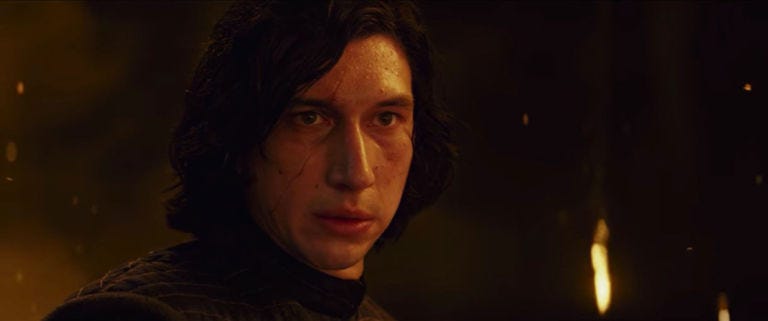
Is Kylo Ren (Adam Driver) a genetic bad seed? (Lucasfilm/Disney)
Is the character of Kylo Ren a genetic bad seed? He has the Skywalker genes and some of those genes tend to the Dark Side, especially if Anakin Skywalker was created by the Sith as he was born without a father. As for Han Solo, Ben Solo/Kylo Ren’s father, Han has his own dark side. He’s a charming, loveable rogue. But Han is also a criminal, a smuggler. In the cantina; did Han shoot first? So it is clear for both Episode IX and the Han Solo movie, the producers have to recognize there is a dark side to Han Solo, modified by his good side. Is Kylo Ren, perhaps unluckily, born as the joining of two sets of dark side chromosomes? Kylo Ren is power hungry, and that could mean that the killing of Snoke was a deliberate act so Kylo Ren can gain the power he craves.
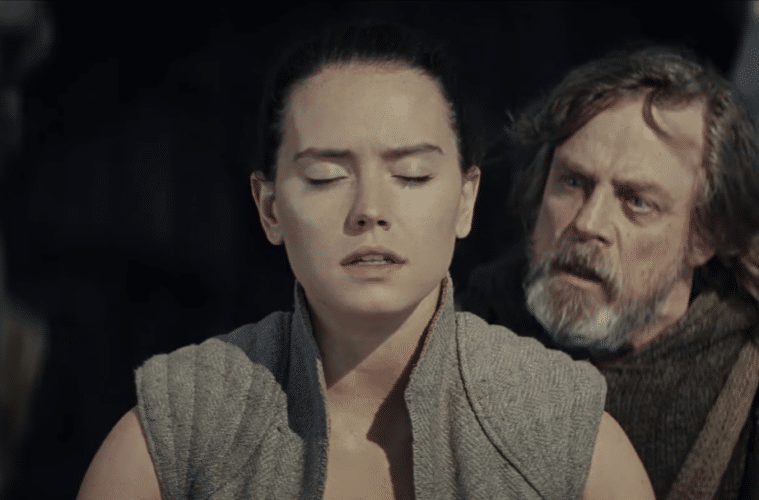
The wounded Jedi Master Luke Skywalker finally decides to pass his knowledge on to Rey, who may the future of the Jedi (Lucasfilm/Disney)
The Star Wars torch has been passed on new generations. Rey is a key character. Could she be a similar character to the young Anakin Skywalker, conceived in secret by the Sith? After all, Anakin’s mother, a slave, was also a nobody. Or we will really find out the story of Rey in Episode IX, perhaps an unexpected mutation?
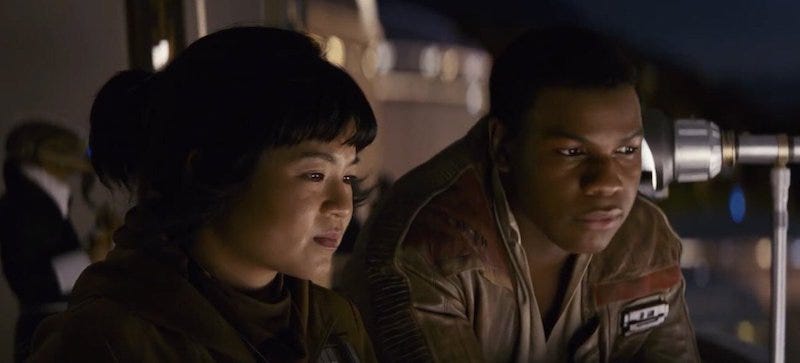
The success of Episode IX will depend largely on how Finn (John Boyega) and Rose (Kelly Marie Tran) develop as characters. (Lucasfilm/Disney)
The characters of Finn and Rose will have to really come into their own and that will a major challenge for J. J. Abrams, co-writer and director of the conclusion to the trilogy. We will have to see what happens to the young stable children.
Finally have we really seen the last of Luke Skywalker? Or will he appear from the Spirit Force to guide Rey or other characters as Obi-wan and Yoda have? For that fans will have to wait and see.
So with principle photography not scheduled until June 2018 with release in December 2019, it will give Disney and Lucasfilm time to find a way to balance not just the Light and Dark sides of the Force but to balance the entertainment fairy tale with the more profound (but attractive to the audience) immortal aspects of the mythic cycle.
Fun fan stuff… my Star Wars model projects
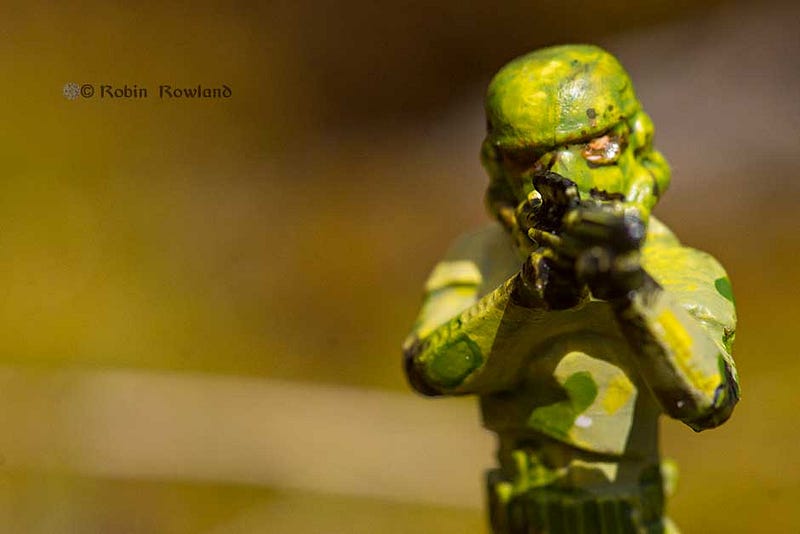
Star Wars Command storm trooper in camouflage.
Star Wars in camo I. If you were a Storm Trooper wouldn’t you want some camouflage?
Star Wars in camo II. A forward observation post on the front line
The hunt for the Millennium Falcon — the diorama
“Do or do not. There is no try” — the diorama
Why did I enlist in the snow troopers?
A lone Imperial AT-AT on dawn patrol

